Opinion & Analysis
The blind spot of PGA Tour players: Long-iron play
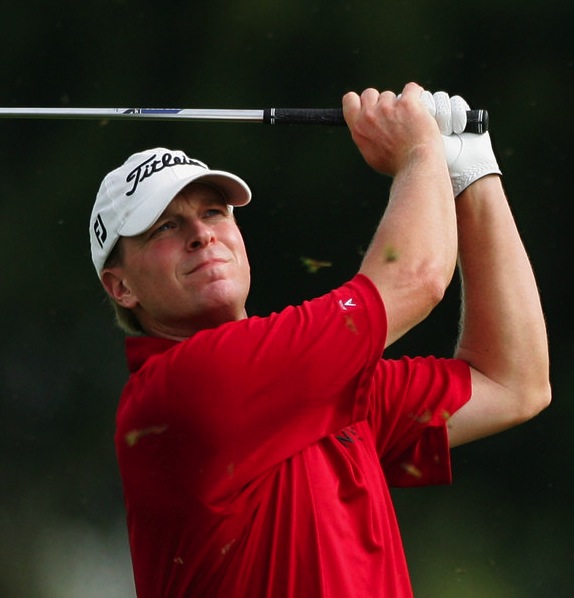
With the PGA Tour’s season winding down to the final tournament of the year, there will be a faction of golfers fighting to make the top 125 on the Money List in order to keep their Tour Card for 2013. I have personally worked with a few PGA Tour players, their caddies and instructors on understanding the game from a statistical standpoint.
When I started the 2012 season working with these clients there were a couple of parts of our initial interaction that surprised me:
1) Each player had made it their goal to be ‘one of the best wedge players on Tour.’
2) Each client initially did not buy into me telling them that in the grand scheme of things, full shot wedge play is not overly important. Particularly on the PGA Tour.
With the PGA Tour’s ShotLink data, the numbers are on display for statisticians like me to decipher the level of importance of each part of the game of golf. It’s very similar to the movie Moneyball and the approach Oakland A’s General Manager, Billy Beane, utilized to build his team based on the cold, hard numbers instead of traditional baseball axioms. But even better, there are far less “moving parts” in the game of golf, making the numbers more distinct and easier to see the correlation to success on Tour.
Despite that, there is still plenty of resistance to approaching the game of golf from a metrics standpoint and every year there are about 75 full time PGA Tour golfers wondering where their entire season went wrong.
***
My development into metrics and the game of golf actually started back when I was only five years old. I immediately took to the game of baseball and each week my dad would go to the local store and grab a few packs of baseball cards and give them to me where I would collect them. Eventually I would spend my entire time reading and studying each card. One of the fascinating parts of baseball is the amount of record keeping of statistics the sport has, dating back to the 19th century.
One of my favorite all-time baseball managers was Billy Martin as he would keep some data on how well certain batters performed against certain pitchers. In fact, in the 1977 American League Championship Series, Martin benched superstar Reggie Jackson because Kansas City’s starting pitcher was Paul Splittorff, who had owned Jackson each time they faced each other. Almost every baseball expert thought Martin was insane, but in the end the Yankees won the game 5-3 and went on to beat the Dodgers to win the World Series.
For better or for worse, statistics lends way to contrarian type of thinking. But if analyzed diligently and with an open mind, it can uncover truths that have eluded even the greatest experts for centuries.
In my own personal journey of golf, I had never understood what the golf term “scoring” exactly meant. Often times, hearing the words “I scored well’ left me with more questions than answers. Generally I would hear it referred to putting and chipping well, but I had plenty of rounds where I shot a low score and did not putt or chip all that well. In fact, one of my lowest rounds ever (64) came with a 4-putt.
With that, I decided to look into the ShotLink data and use my background in statistics to see if I could figure out the level of importance that certain parts of the game have on the success of PGA Tour golfers. In the process, I wound up uncovering a truth that has been long ignored by countless Tour players.
***
Before I go on, the wedge game does matter in the game of golf. In fact, every part of the game matters in the game of golf. If a golfer improves his fairway bunker play, that will lower their scores over a period of time. However, if a golfer improves their putting, that will have a bigger impact on lowering their scores than if they were to just improve their fairway bunker player. Thus, a metrics based approach to golf is about determining the level of importance that certain parts of the game have and then focusing on improving the parts of the game that have the highest level of importance in order to improve a golfer’s scores.
One of my first observations was that Tour players typically do not hit the ball well from every location with every type of club in the bag. The golfers considered to be top tier ballstrikers are usually good off the tee and then excel with certain irons like the mid-irons or the long irons or with their wedges. But to find a golfer who can hit it well off the tee and hit it well with each iron is quite rare.
I ended up splitting the game in different categories like Driving Effectiveness, Putts Gained and Short Game Play. But for the approach shots, I split them into the following categories:
- Birdie Zone Play (shots from 75-125 yards)
- Safe Zone Play (shots from 125-175 yards)
- Danger Zone Play (shots from 175-225 yards)
What I uncovered was that Danger Zone Play has the strongest correlation to success on Tour than ANY other part of the game, including putting and driving effectiveness. And it has a far stronger correlation to success on Tour than Safe Zone Play and Birdie Zone Play. Despite that, these clients of mine on the PGA Tour would tell me how important it was for them to be one of the best wedge players on Tour.
While I was a little frustrated with their desires to be the best at a part of the game that was relatively unimportant to their success, I did understand where they were coming from. I had to remember that before I did this statistical research, I had the same ideas of good Tour players would almost always get up-and-in on any shot from inside 100 yards. And if a Tour player was unable to execute from that distance, they would not find themselves on Tour for very long. This led me to wondering where this faulty thinking came from.
***
Currently, the leader in Birdie Zone play is Steve Stricker, who has hit his Birdie Zone shots an average of 15.74 feet to the cup. The average Tour player from the Birdie Zone has hit his shots 20.35 feet to the cup.
The general misconception for golfers, including actual PGA Tour golfers, is that once a good Tour player gets a wedge in their hands they will hit it close and have a tap in putt. But as the data shows, that is far from the reality. The best player from 75-125 yards is averaging almost 16 feet left to the cup on shots from this range. The average Tour player is leaving it over 20 feet to the cup.
Furthermore, the Tour average putts made percentage from 15-20 feet is only 18.3 percent. From 20-25 feet the average make percentage on Tour is 11.7 percent. Therefore, Tour players are not having a lot of tap-ins when they get a full swing wedge in their hand, but also their odds of getting up-and-in with a full swing wedge in their hands are slim at best.
Still, we need to see what the correlation between Birdie Zone Play and success on Tour actually. To give a better idea, take a look at the top-10 Birdie Zone players in 2012 and their ranking on the Money List:
Here’s a list of the players in the bottom-10 of Birdie Zone Play and their Money Ranking:
Out of the players in both lists, the bottom-10 in the Birdie Zone actually have 6 players in the top-100 on the Money List versus the top-10 Birdie Zone players which only has 5 players in the top-100 on the Money List.
Let’s compare that to the best and the worst of the Danger Zone golfers. Here is the top-10 Danger Zone golfers and their rankings on the Money List:
Here’s the bottom-10 in Danger Zone play:
Every single player in the top-10 in the Danger Zone will be in the top-125 on the Money List in 2012, regardless of what happens at Disney. But even better, those who have finished in the top-10 in the Danger Zone have had resounding success on Tour this year. Whereas four of the top-10 Birdie Zone golfers (Mulroy, Taylor, Thatcher and O’Hern) will likely have to win at Disney in order to finish in the top-125 on the Money List.
This is the blind spot for many PGA Tour players. They keep working doggedly on their wedge game whereas if they used their efforts towards the longer irons and hybrids, they would almost assuredly keep their card and get closer to nirvana, winning a PGA Tour event.
I think the cause of the ‘blind spot’ is television. Television producers are far more interested in shots that wind up close to the pin than the shots that actually have a greater impact of a golfer separating themselves from the rest of the field. That is why we see so much putting on televised rounds, those are the shots that golfers are most likely to make. When it comes to full swing shots, golfers are more likely to hit a wedge shot closer to the pin. And to make it even more visually appealing, wedge shots are more likely to get backspin as well.
Thus, the perception is that Tour players stick every wedge shot and get up-and-in with ease. That is what we usually see every week on TV. The reality is far different and that the more spectacular shot happens when a golfer hits a 190 yard shot to 15-feet with no back spin. But television ratings always take precedent over mundane facts.
Click here for more discussion in the “Tour Talk” forum.
- LIKE10
- LEGIT1
- WOW3
- LOL0
- IDHT0
- FLOP0
- OB0
- SHANK0
Opinion & Analysis
The Wedge Guy: What really makes a wedge work? Part 1

Of all the clubs in our bags, wedges are almost always the simplest in construction and, therefore, the easiest to analyze what might make one work differently from another if you know what to look for.
Wedges are a lot less mysterious than drivers, of course, as the major brands are working with a lot of “pixie dust” inside these modern marvels. That’s carrying over more to irons now, with so many new models featuring internal multi-material technologies, and almost all of them having a “badge” or insert in the back to allow more complex graphics while hiding the actual distribution of mass.
But when it comes to wedges, most on the market today are still single pieces of molded steel, either cast or forged into that shape. So, if you look closely at where the mass is distributed, it’s pretty clear how that wedge is going to perform.
To start, because of their wider soles, the majority of the mass of almost any wedge is along the bottom third of the clubhead. So, the best wedge shots are always those hit between the 2nd and 5th grooves so that more mass is directly behind that impact. Elite tour professionals practice incessantly to learn to do that consistently, wearing out a spot about the size of a penny right there. If impact moves higher than that, the face is dramatically thinner, so smash factor is compromised significantly, which reduces the overall distance the ball will fly.
Every one of us, tour players included, knows that maddening shot that we feel a bit high on the face and it doesn’t go anywhere, it’s not your fault.
If your wedges show a wear pattern the size of a silver dollar, and centered above the 3rd or 4th groove, you are not getting anywhere near the same performance from shot to shot. Robot testing proves impact even two to three grooves higher in the face can cause distance loss of up to 35 to 55 feet with modern ‘tour design’ wedges.
In addition, as impact moves above the center of mass, the golf club principle of gear effect causes the ball to fly higher with less spin. Think of modern drivers for a minute. The “holy grail” of driving is high launch and low spin, and the driver engineers are pulling out all stops to get the mass as low in the clubhead as possible to optimize this combination.
Where is all the mass in your wedges? Low. So, disregarding the higher lofts, wedges “want” to launch the ball high with low spin – exactly the opposite of what good wedge play requires penetrating ball flight with high spin.
While almost all major brand wedges have begun putting a tiny bit more thickness in the top portion of the clubhead, conventional and modern ‘tour design’ wedges perform pretty much like they always have. Elite players learn to hit those crisp, spinny penetrating wedge shots by spending lots of practice time learning to consistently make contact low in the face.
So, what about grooves and face texture?
Grooves on any club can only do so much, and no one has any material advantage here. The USGA tightly defines what we manufacturers can do with grooves and face texture, and modern manufacturing techniques allow all of us to push those limits ever closer. And we all do. End of story.
Then there’s the topic of bounce and grinds, the most complex and confusing part of the wedge formula. Many top brands offer a complex array of sole configurations, all of them admittedly specialized to a particular kind of lie or turf conditions, and/or a particular divot pattern.
But if you don’t play the same turf all the time, and make the same size divot on every swing, how would you ever figure this out?
The only way is to take any wedge you are considering and play it a few rounds, hitting all the shots you face and observing the results. There’s simply no other way.
So, hopefully this will inspire a lively conversation in our comments section, and I’ll chime in to answer any questions you might have.
And next week, I’ll dive into the rest of the wedge formula. Yes, shafts, grips and specifications are essential, too.
- LIKE13
- LEGIT4
- WOW1
- LOL1
- IDHT2
- FLOP2
- OB1
- SHANK1
Golf's Perfect Imperfections
Golf’s Perfect Imperfections: Amazing Session with Performance Coach Savannah Meyer-Clement

In this week’s episode, we spent some time with performance coach Savannah Meyer-Clement who provides many useful insights that you’ll be able to implement on the golf course.
- LIKE0
- LEGIT0
- WOW0
- LOL0
- IDHT0
- FLOP0
- OB0
- SHANK0
19th Hole
Vincenzi’s 2024 RBC Heritage betting preview: Patrick Cantlay ready to get back inside winner’s circle

Just a two-hour drive from Augusta National, the PGA TOUR heads to Harbour Town Golf Links in Hilton Head Island, S.C. Hilton Head Island is a golfer’s paradise and Harbour Town is one of the most beautiful and scenic courses on the PGA TOUR.
Harbour Town Golf Links is a par-71 that measures 7,121 yards and features Bermuda grass greens. A Pete Dye design, the course is heavily tree lined and features small greens and many dog legs, protecting it from “bomb-and-gauge” type golfers.
The field is loaded this week with 69 golfers with no cut. Last year was quite possibly the best field in RBC Heritage history and the event this week is yet another designated event, meaning there is a $20 million prize pool.
Most of the big names on the PGA Tour will be in attendance this week with the exceptions of Hideki Matsuyama and Viktor Hovland. Additionally, Webb Simpson, Shane Lowry, Gary Woodland and Kevin Kisner have been granted sponsors exemptions.
Past Winners at Harbour Town
- 2023: Matt Fitzpatrick (-17)
- 2022: Jordan Spieth (-13)
- 2021: Stewart Cink (-19)
- 2020: Webb Simpson (-22)
- 2019: CT Pan (-12)
- 2018: Sotoshi Kodaira (-12)
- 2017: Wesley Bryan (-13)
- 2016: Branden Grace (-9)
- 2015: Jim Furyk (-18)
In this article and going forward, I’ll be using the Rabbit Hole by Betsperts Golf data engine to develop my custom model. If you want to build your own model or check out all of the detailed stats, you can sign up using promo code: MATTVIN for 25% off any subscription package (yearly is best value).
Key Stats For Harbour Town
Let’s take a look at key metrics for Harbour Town Golf Links to determine which golfers boast top marks in each category over their past 24 rounds.
Strokes Gained: Approach
Strokes Gained: Approach is exceedingly important this week. The greens at Harbour Town are about half the size of PGA TOUR average and feature the second-smallest greens on the tour. Typical of a Pete Dye design, golfers will pay the price for missed greens.
Total SG: Approach Over Past 24 Rounds
- Scottie Scheffler (+1.27)
- Tom Hoge (+1.27)
- Corey Conners (+1.16)
- Austin Eckroat (+0.95)
- Cameron Young (+0.93)
Good Drive %
The fairways at Harbour Town are tree lined and feature many dog legs. Bombers tend to struggle at the course because it forces layups and doesn’t allow long drivers to overpower it. Accuracy is far more important than power.
Good Drive % Over Past 24 Rounds
- Brice Garnett (88.8%)
- Shane Lowry (+87.2%)
- Akshay Bhatia (+86.0%)
- Si Woo Kim (+85.8%)
- Sepp Straka (+85.1%)
Strokes Gained: Total at Pete Dye Designs
Pete Dye specialists tend to play very well at Harbour Town. Si Woo Kim, Matt Kuchar, Jim Furyk and Webb Simpson are all Pete Dye specialists who have had great success here. It is likely we see some more specialists near the top of the leaderboard this week.
SG: TOT Pete Dye per round over past 36 rounds:
- Xander Schauffele (+2.27)
- Scottie Scheffler (+2.24)
- Ludvig Aberg (+2.11)
- Brian Harman (+1.89)
- Sungjae Im (+1.58)
4. Strokes Gained: Short Game (Bermuda)
Strokes Gained: Short Game factors in both around the green and putting. With many green-side bunkers and tricky green complexes, both statistics will be important. Past winners — such as Jim Furyk, Wes Bryan and Webb Simpson — highlight how crucial the short game skill set is around Harbour Town.
SG: SG Over Past 24 Rounds
- Jordan Spieth (+1.11)
- Taylor Moore (+1.02)
- Wyndham Clark (+0.98)
- Mackenzie Hughes (+0.86)
- Andrew Putnam (+0.83)
5. Greens in Regulation %
The recipe for success at Harbour Town Golf Links is hitting fairways and greens. Missing either will prove to be consequential — golfers must be in total control of the ball to win.
Greens in Regulation % over past 24 rounds:
- Brice Garnett (+75.0%)
- Scottie Scheffler (+69.9%)
- Corey Conners (+69.0%)
- Shane Lowry (+68.3%)
- Patrick Rodgers (+67.6%)
6. Course History
Harbour Town is a course where players who have strong past results at the course always tend to pop up.
Course History over past 24 rounds:
- Patrick Cantlay (+2.34)
- Cam Davis (+2.05)
- J.T. Poston (+1.69)
- Justin Rose (+1.68)
- Tommy Fleetwood (+1.59)
The RBC Heritage Model Rankings
Below, I’ve compiled overall model rankings using a combination of the five key statistical categories previously discussed — SG: Approach (24%), Good Drives (20%), SG: SG (14%), SG: Pete Dye (14%), GIR (14%), and Course History (14%)
- Shane Lowry
- Russell Henley
- Scottie Scheffler
- Xander Schauffele
- Corey Conners
- Wyndham Clark
- Christiaan Bezuidenhout
- Matt Fitzpatrick
- Cameron Young
- Ludvig Aberg
2024 RBC Heritage Picks
Patrick Cantlay +2000 (FanDuel)
With the exception of Scottie Scheffler, the PGA Tour has yet to have any of their star players show peak form during the 2024 season. Last week, Patrick Cantlay, who I believe is a top-5 players on the PGA Tour, took one step closer to regaining the form that’s helped him win eight events on Tour since 2017.
Cantlay limped into the Masters in poor form, but figured it out at Augusta National, finishing in a tie for 20th and ranking 17th for the week in Strokes Gained: Ball Striking. The former FedEx Cup champion will now head to one of his favorite golf courses in Harbour Town, where he’s had immaculate results over the years. In his six trips to the course, he’s only finished worse than 7th one time. The other finishes include three third places (2017, 2019, 2023) and one runner-up finish (2022). In his past 36 rounds at Harbour Town, Cantlay ranks 1st in Strokes Gained: Total per round at the course by a wide margin (+2.36).
Cantlay is winless since the 2022 BMW Championship, which is far too long for a player of his caliber. With signs pointing to the 32-year-old returning to form, a “signature event” at Harbour Town is just what he needs to get back on the winning track.
Tommy Fleetwood +3000 (FanDuel)
I truly believe Tommy Fleetwood will figure out a way to win on American soil in 2024. It’s certainly been a bugaboo for him throughout his career, but he is simply too talented to go another season without winning a PGA Tour event.
At last week’s Masters Tournament, Fleetwood made a Sunday charge and ended up finishing T3 in the event, which was his best ever finish at The Masters. For the week, the Englishman ranked 8th in the field in Strokes Gained: Approach, 10th in Strokes Gained: Ball Striking and 16th in Strokes Gained: Putting.
Harbour Town is a perfect layout for Fleetwood, and he’s had relative success at this Pete Dye design in the past. In his four trips to the course, he’s finished inside of the top 25 three times, with his best finish, T10, coming in 2022. The course is pretty short and can’t be overpowered, which gives an advantage to more accurate players such as Fleetwood. Tommy ranks 8th in the field in Good Drive % and should be able to plot his way along this golf course.
The win is coming for Tommy lad. I believe there’s a chance this treasure of a golf course may be the perfect one for him to finally break through on Tour.
Cameron Young +3300 (FanDuel)
Cameron Young had a solid Masters Tournament last week, which is exactly what I’m looking for in players who I anticipate playing well this week at the RBC Heritage. He finished in a tie for 9th, but never felt the pressure of contending in the event. For the week, Young ranked 6th in Strokes Gained: Off the Tee and 6th in Strokes Gained: Ball Striking.
Despite being one of the longest players off the tee on the PGA Tour, Young has actually played some really good golf on shorter tracks. He finished T3 at Harbour Town in 2023 and ranks 20th in the field in Good Drive% and 16th in Greens in Regulation in his past 24 rounds. He also has strong finishes at other shorter courses that can take driver out of a players hand such as Copperhead and PGA National.
Young is simply one of the best players on the PGA Tour in 2024, and I strongly believe has what it takes to win a PGA Tour event in the very near future.
Corey Conners +5500 (FanDuel)
Corey Conners has had a disappointing year thus far on the PGA Tour, but absolutely loves Harbour Town.
At last week’s Masters Tournament, the Canadian finished T30 but ranked 20th in the field in Strokes Gained: Approach. In his past 24 rounds, Conners ranks 3rd in the field in Strokes Gained: Approach, 3rd in Greens in Regulation % and 24th in Good Drive %.
In Conners’ last four trips to Harbour Town, his worst finish was T31, last season. He finished T4 in 2021, T12 in 2022 and ranks 8th in Strokes Gained: Total at the course over his past 36 rounds.
Conners hasn’t been contending, but his recent finishes have been encouraging as he has finished in the top-25 in each of his past three starts prior to The Masters, including an impressive T13 at The PLAYERS. His recent improvement in ball striking as well as his suitability for Harbour Town makes Conners a high upside bet this week.
Shane Lowry (+7500) (FanDuel)
When these odds were posted after Lowry was announced in the field, I have to admit I was pretty stunned. Despite not offering much win equity on the PGA Tour over the last handful of years, Shane Lowry is still a top caliber player who has the ability to rise to the top of a signature event.
Lowry struggled to score at The Masters last week, but he actually hit the ball really well. The Irishman ranked 1st for Strokes Gained: Approach on the week and 7th in Strokes Gained: Ball Striking. As usual, it was the putter that let him down, as he ranked 60th in the field in Strokes Gained: Putting.
Harbour Town is most definitely one of Lowry’s favorite courses on the PGA Tour. In his six starts there, he’s finished in the top 10 three times, including third twice. Lowry is sensational at Pete Dye designs and ranks 7th in Strokes Gained: Total in his past 36 rounds on Dye tracks.
Lowry is perfect for Harbour Town. In his past 24 rounds, he ranks 5th in Strokes Gained: Approach, 2nd in Good Drive% and 5th in Green in Regulation %. If he figures it out on the greens, Shane could have his first win in America since 2015.
Lucas Glover +12000 (FanDuel)
This is one of my weekly “bet the number” plays as I strongly believe the odds are just too long for a player of Glover’s caliber. The odds have been too long on Glover for a few weeks now, but this is the first event that I can get behind the veteran being able to actually contend at.
Glover is quietly playing good golf and returning to the form he had after the understandable regression after his two massive victories at the end of 2023. He finished T20 at The Masters, which was his best ever finish at Augusta National. For the week, Lucas ranked 18th for Strokes Gained: Approach and 20th in Strokes Gained: Ball Striking.
Over his past 24 rounds, Glover ranks 9th in Strokes Gained: Approach and 13th in Good Drive %. Harbour Town is a short course that the 44-year-old will be able to keep up with the top players on Tour off the tee. He’s played the course more than 20 times, with mixed results. His best finishes at Harbour Town include a T7 in 2008, but recently has a finish of T21 in 2020.
Glover has proven he can contend with the stars of the Tour on any given week, and this number is flat out disrespectful.
- LIKE30
- LEGIT5
- WOW2
- LOL1
- IDHT1
- FLOP2
- OB0
- SHANK2
-

 19th Hole1 week ago
19th Hole1 week agoDave Portnoy places monstrous outright bet for the 2024 Masters
-

 19th Hole3 weeks ago
19th Hole3 weeks agoThings got heated at the Houston Open between Tony Finau and Alejandro Tosti. Here’s why
-

 19th Hole1 week ago
19th Hole1 week agoTiger Woods arrives at 2024 Masters equipped with a putter that may surprise you
-

 19th Hole2 weeks ago
19th Hole2 weeks agoReport: Tiger Woods has ‘eliminated sex’ in preparation for the 2024 Masters
-

 19th Hole4 days ago
19th Hole4 days agoTwo star names reportedly blanked Jon Rahm all week at the Masters
-

 19th Hole4 days ago
19th Hole4 days agoNeal Shipley presser ends in awkward fashion after reporter claims Tiger handed him note on 8th fairway
-

 19th Hole3 days ago
19th Hole3 days agoReport: LIV Golf identifies latest star name they hope to sign to breakaway tour
-

 19th Hole2 weeks ago
19th Hole2 weeks agoAddiction, spinal fusion, and scam artists – Everything Anthony Kim revealed in candid interview with David Feherty

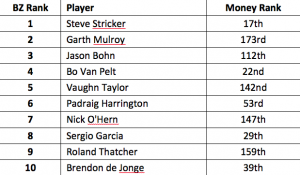
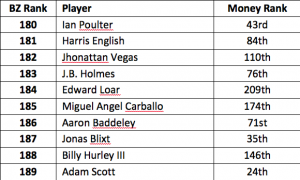
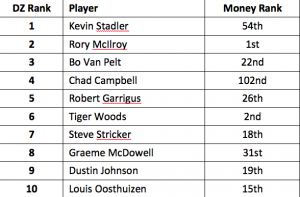
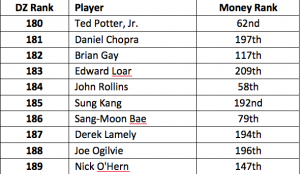












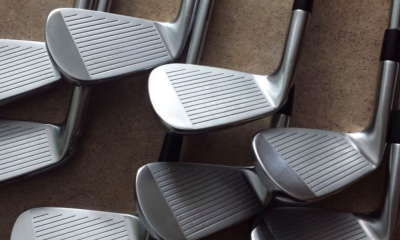














Louis
Aug 10, 2014 at 5:25 am
You say a player who averages 15 feet from 100 yards has a slim chance of making birdie because tour pros only make 20% of their 15 footers. How about all the shots that land inside 15 feet though?
If you hit 30 shots and average 15 feet from 100 yards it means you will have 4 putts inside of 4 feet (let’s say you make 4), 6 from 5-10 (let’s say you make 3), 5 from 11-15 (let’s say you make 2), and 15 from 15-30 (let’s assume you make 2). That gives you a better than 33% chance of making birdie.
Winning tournaments comes from making birdies and not screwing up badly. Going from a 7% margin of error to 5% margin of error with long irons isn’t gonna make you score any better.
Not spraying your long irons will help immensely. Because that’s a really easy place to lose strokes.
Lesson: keep the ball in play (hit greens) with your long irons. That’s it. Don’t worry about being better than able to hit it within 50 feet of where you aim consistently (still hard to do). Going from 50 feet to 40 feet won’t help.
Eliminate inconsistencies that produce big misses.
Once you have that down, to score well, hitting the wedges closer is the easiest way.
Sam
Jun 18, 2013 at 5:33 am
Interesting stuff, here’s my 2cents worth…
PGA Tour players are just like other golfers, they follow trends. In the 90’s everyone on Tour jumped on the 52, 56, 60 bandwagon with Tom Kite, when he took distance control to a new level. Then along came Tiger with 48, 54, 58 and they all dumped a wedge. Lately, club lofts have changed the make up of sets, making 3 iron redundant in many cases (as shown above). The reason the DZ looks more important to scoring than the BZ is that relative to the other parts of their game the average PGA Tour Pro is poor in the BZ. The reason for this is simple: not enough tools to do the job. Modern PW clubs have become much stronger, instead of keeping the loft/distance gaps even, everyone followed Tiger and minimized the short end of their set. No doubt, more options and more full shot yardages will result in closer to the hole with wedges, it would be interesting to look at the correlation between number of scoring clubs and proximity to the hole, pretty sure you will find that guys with 3-4 wedges get it closer more often than the two club guys. Now that’s a blind spot!
JD
Nov 13, 2013 at 5:15 am
Interesting comment. But what I think you have failed to recognise is the fact PGA tour courses have become much longer and therefore require more clubs down the long end of the set make up. As a professional caddie and also a pro myself I have seen this first hand. There are also more courses with par 3 holes that are between 200-225 yards, couple that with longer par 4 holes that require longer, higher and softer shots players are forced into a hybrid as well as 3 irons. This is one reason I feel players are dumping the extra edge.
Mike
Feb 21, 2013 at 10:11 pm
The article is interesting but I am not sure that using Money List as a correlation to Birdie/Danger Zone is a statistically sound method. The Money List is a total of earnings but that is subject to a variable you have not accounted for which is the number of starts a player has on the Tour. Even an average PGA Tour player will have more money when they have more starts. A better comparison of earnings to player performance statistics would at least use “earnings per start” to eliminate the variable related to the number of starts.
Also, isn’t there some relationship between BZ, SZ and DZ that you have not accounted for? For example, Steve Stricker rates Top 10 in BZ and DZ efficiency and Adam Scott is 189th in BZ and obviously not Top 10 in DZ. One would think, based on the analysis, that Adam Scott would finish far below Steve Stricker yet the opposite is true. Scott (16 starts) actually finished with slightly higher earnings per start ($181,000) than did Stricker (19 starts and $180,000 per start).
Alex
Feb 14, 2013 at 2:40 pm
First of all great article…
Last year i actually kept record of 30 rounds and analyzed them through out. I took lowest 10 rounds and see what i did best during those rounds. This is what i found. 7 out of 10 rounds i hit 12 fairways each of those rounds, however also note i took more 3 woods and hybrids off the tee that left me a lot of 150-185 yard approaches. In those rounds i hit about 14 greens on avg. What this concluded for me is that i am a lot better hitting 7,6,5 and hybrids off the fairway than wedges from the rough. I am pretty decent putter and will not really 3 putt very often, however i will also not drain too many 20 footers for birdies. If Tour avg from the BZ is about 20 ft then i will be definitely over that, so as an amateur if i want to score better but more importantly consistently better i should be hitting 3/5 woods off the tees and hitting 7 irons into greens taking my 2 putts and going to the next hole. This is where this article is dead on, for me to get better either i need to drive better and be on the short grass with my driver leaving wedges in or improve my approaches from 150-185. Now what is easier to improve….
Jeff
Feb 14, 2013 at 12:00 pm
Great article, really can relate to this.
Dane
Feb 13, 2013 at 2:01 pm
Great article Mark. Being a golf professional this has put into writing what plenty of golf pros think. I will definitely look more into your work!
Philip
Feb 8, 2013 at 11:30 am
Wow! I think I need to become a statistician to analyze my golf game! Call me weird, but these are fun articles!
mark burk
Nov 5, 2012 at 9:28 am
All of the players you metion are good danger zone players are longer hitters and bad dangerzone players are short hitters. 175 to 225 for the good ones mention are mostly mid irons that can hold the firm pga tour greens, they also will be able to hit par 5’s in two more often which is where these guys make there birdies with shorter clubs and since most the par 3’s on tour are over 200 yards plays to the advantage of the longer hitters. So it would be better most of the world class player have good long game because of distance. If you want to talk about where weekend warrior can save shots it is with the shortgame. If a player can eliminate 3 putts and get up and down more often it will save them more strokes than being a good iron player from 175 to 225. Keeping the ball in play, eliminating 3 putts and decent short game will keep the score down for the average weekend golfer. Every time I go to range at my club the chipping and putting green are empty and the range is full. What will lower a score faster going from 38 putts a round to 30 or hitting good long iron or hybrid shots which will maybe be hit 4 times a round. This is for the weekend player
Richie Hunt
Nov 7, 2012 at 9:54 am
Mark,
I only showed the top-10 and bottom-10, but there is no substantative statistical correlation between distance off the tee or clubhead speed or a combination of the two and DZ play. And I have ran these numbers since 2003 for Distance and DZ play and thru 2007 for clubhead speed and DZ play.
There are plenty of examples of shorter hitting, low clubhead speed players that play great from the DZ each year. McDowell is ranked 8th in the DZ and not very long. Same with Stricker. Furyk is ranked 12th and routinely does great in the DZ. Same for other shorter hitters like David Toms (who was ranked #1 in 2011), Heath Slocum, and Zach Johnson.
Meanwhile there are longer hitters that struggle from the DZ. Like Chopra, Driscoll, Lamely, and Mark Anderson (currently ranked 174th) and Jhonattan Vegas (currently ranked 175th).
Distance helps…slightly. But it’s not enough help for Tour players to overcome a lack of skill in the Danger Zone.
Brett Adamkiewicz
Nov 1, 2012 at 11:03 am
What a well rounded article, and explained better than I have ever heard it. I have always taken a different thought process compared to the average joe. Not to exaggerate but we have all heard the phrase “drive for show and putt for dough” a million times. Fact of the matter is you will never win any “dough” if your superb putting skills are saving bogey and double bogeys all the time. On a side topic I am curious as too the percentage of penalty strokes taken in a round are due to tee shots and the “danger zone” shots. I know the phrase doesn’t exactly fit with the danger zone but it is all relative. 175 and out is what I call my scoring zone. I can have a bad putting and chipping day and still be sub 80. If I can’t get off the tee and can’t get around the green, the limit on my score…. I am taking a trip with 7 of my buddies to Kiawah Island this weekend and I am going to put this to the test! Most of them are all mid to low handicappers and can play well! I am going to have a little fun with this and track their scoring relative to your “Danger Zone” and off the tee. Thank you for this article and I hope more people will read this and pay attention.
Brett Adamkiewicz
Nov 1, 2012 at 11:05 am
The sky is the limit on my score. Left out that part.
Dan
Oct 31, 2012 at 8:12 pm
Fantastic article, very insightful. It will be great to stop focusing on the “Glamorous” parts of the game and focus more on the shots that lower my score.
DaleH
Oct 31, 2012 at 5:02 pm
Exactly.. most amatures do struggle with the short game but really struggle with longer irons like myself. I’m usually on hitting into greens with say an 8 iron or less, 7-4 not as good, the longer the iron the the less my chances. Time to practice more on the long irons. Thanks for the facts.
Pingback: GolfWRX.com – The blind spot of PGA Tour players: Long-iron play | Golf Products Reviews